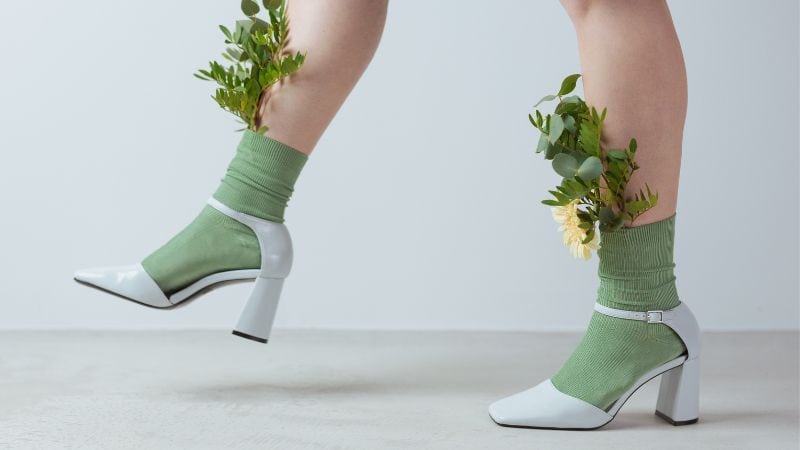
Key Takeaways
Yes. Compression socks help relieve neuropathy by promoting blood circulation, alleviating pain, decreasing swelling, and preventing blood clots. In this article, we’ll illustrate specific categories of neuropathy syndromes so that you can learn about your current condition to choose the very compression socks for yourself. Besides, you’ll then understand the benefits of compression socks for neuropathy and practical tips for selecting neuropathy compression socks based on your own circumstances. Now, let’s delve into the secrets of neuropathy socks.
What Is Neuropathy

Neuropathy refers to a range of medical conditions that involve damage to your peripheral nerves. These are the nerves outside of your brain and spinal cord, collectively known as your total nervous system. The damage can lead to pain, numbness, and an irregular sensation in the affected areas, typically in your hands and feet.
The most common type of neuropathy is diabetic neuropathy, which is nerve damage resulting from diabetes. Consistently high blood sugar levels can injure nerves throughout your body, but diabetic neuropathy most often damages nerves in your legs and feet.
Beyond diabetes, several factors can cause neuropathy, including:
- Autoimmune diseases: such as lupus and rheumatoid arthritis
- Infections: some viruses and bacteria, such as HIV and Lyme disease, can cause nerve damage
- Other diseases: including kidney disorders, liver diseases, and hypothyroidism can also affect nerve tissue
Peripheral neuropathy can manifest in different forms and affect your nerves in various ways. It can include:
- Sensory neuropathy: affecting sensations
- Motor neuropathy: which impacts muscle movement
- Autonomic neuropathy: that involves involuntary functions such as blood pressure and digestion
Your experience with neuropathy can vary widely. Some may feel a slight tingling, while others may experience a more intense stabbing pain. If you suspect you might have neuropathy, it’s important to consult a healthcare professional for an accurate diagnosis and appropriate treatment. You may also turn to sinoknit to choose your own customized compression socks for neuropathy that suits you best.
The Benefits of Compression Socks for Neuropathy
Compression socks are designed to promote blood circulation by applying gentle pressure to your legs, which can be advantageous for managing neuropathy. The use of these socks can lead to improved oxygen delivery to your muscle tissues, potentially leading to reduced pain and swelling in the affected areas.
When selecting compression socks for neuropathy, it’s important to consider the compression levels. Generally, a moderate level, such as 30-40 mmHg, is recommended for therapeutic benefits without causing discomfort. This range is thought to balance the needs for pressure and comfort effectively.
Here are some specific benefits you might experience:
| Benefit | Description |
|---|---|
| Reduce Swelling and Discomfort | Apply gentle pressure to improve circulation and prevent fluid buildup, reducing swelling (edema) and associated discomfort in feet and legs. |
| Improve Blood Flow and Circulation | Graduated compression encourages better blood flow from legs/feet back towards the heart, relieving neuropathy pain, numbness, tingling, and “pins and needles” sensations caused by nerve damage. |
| Enhance Balance and Stability | Provide support and relieve pressure on joints, helping improve balance, posture, and stability which can be affected by neuropathy-related muscle weakness. |
| Protect Feet and Prevent Complications | Act as a physical barrier, protecting insensitive feet from cuts/sores and promoting healing of existing wounds. Helps prevent serious complications like infections or gangrene. |
| Relieve Pain and Discomfort | Patients with diabetic neuropathy report compression socks significantly relieve painful “pins and needles” sensations in legs/feet. |
Key Considerations:
- Get properly fitted medical-grade graduated compression socks (20-30 mmHg or 30-40 mmHg)
- Choose moisture-wicking, flexible, and comfortable materials
In addition to these physical benefits, the supportive nature of compression socks may improve your balance and coordination while walking, giving you a sense of added stability. This support can also play a role in the management of your neuropathy symptoms, allowing you to continue with your daily activities more comfortably.
It is always recommended to consult with a healthcare provider before starting any new treatment or therapy, including compression socks, to ensure they are suitable for your individual health needs.
Compression Stockings for Your Symptoms
The following table has detailed recommended compression stocking levels for different symptoms of neuropathy for your reference:
| Neuropathy Symptom | Recommended Compression Level | Benefits |
|---|---|---|
| Numbness, Tingling | 15-20 mmHg (Light to Moderate) | Improves circulation to relieve numbness and “pins and needles” sensations in legs/feet. |
| 20-30 mmHg (Moderate) | More effective for persistent, severe tingling/numbness. | |
| Neuropathic Pain | 15-20 mmHg (Light to Moderate) | Helps reduce mild to moderate neuropathic pain by improving blood flow. |
| 20-30 mmHg (Moderate) | Recommended for more severe, chronic neuropathic pain. | |
| Swelling, Edema | 20-30 mmHg (Moderate to Firm) | Prevents fluid buildup and reduces swelling in legs/feet, common with neuropathy. |
| Balance, Stability Issues | 15-20 mmHg (Light to Moderate) | Provides physical support and compression to improve balance/stability with muscle weakness. |
| Protecting Insensitive Feet | Any level (15-20 mmHg or higher) | Acts as a barrier to protect numb feet from cuts, sores, ulcers that may go unnoticed. |
General Guidelines:
- Start with 15-20 mmHg for milder symptoms, move up if needed.
- 20-30 mmHg may be recommended by a doctor for more severe cases.
- Avoid very high compression (30-40 mmHg) unless specifically prescribed.
- Proper fit is crucial – too tight can potentially worsen symptoms.
Tips for Selecting Neuropathy Compression Socks

- Check with your doctor first
Before using compression socks for neuropathy, it’s important to consult your doctor, as compression may not be suitable for everyone, especially those with certain conditions like peripheral vascular disease. Your doctor can also recommend the appropriate compression level for your needs. - Know the compression levels
Compression socks come in different levels measured in mmHg. Light (15-20 mmHg) or moderate (20-30 mmHg) compression is often recommended for neuropathy symptoms like numbness, tingling, and mild swelling. Higher firm (30-40 mmHg) compression may be advised by a doctor for more severe cases. - Look for graduated compression
The compression should be graduated, with the highest pressure at the ankles and gradually decreasing up the leg. This promotes better circulation. - Choose moisture-wicking, antimicrobial materials
Socks made from breathable, moisture-wicking fibers like bamboo can help keep feet dry and prevent bacterial growth, which is beneficial for those prone to neuropathy-related wounds or foot issues. - Opt for cushioned soles and smooth toe seams
Extra cushioning in the soles and smooth toe seams can provide added comfort and protection for insensitive feet affected by neuropathy. - Consider antibacterial properties
If you have existing wounds or cuts, look for socks with antibacterial properties from materials like copper to reduce infection risk. - Get properly fitted
Ill-fitting compression socks can cause discomfort and indentations and potentially worsen symptoms. Get professionally fitted for the right size. - Replace socks regularly
Compression socks should be replaced every 3-6 months as they can lose their compression ability over time.
Sinoknit, Why Us?
Ningbo Sinoknit Co., Ltd. is a leading wholesale custom sock manufacturer located in Zhuji, China. Our headquarters is in Ningbo, one of China’s major ports. Since 2004, we’ve been specializing in producing various types of high-quality socks using cutting-edge materials such as 100% cotton, combed cotton, mercerized cotton, chemical fiber blended yarn, and lycra.
Our socks factory is equipped with over 300 computerized sock knitting machines imported from Italy and Korea. This allows us to produce up to 20 million pairs of socks per year. With an extensive range of over 100 sock varieties, we offer 96-needle, 108-needle, 120-needle, 132-needle, 144-needle, 168-needle, and 200-needle slim socks, terry socks, cotton-yarn socks, and woolen pants.
Our products are exported to more than 20 countries and regions, including Korea, Japan, Southeast Asia, the Middle East, Europe, and North America. Trust us to provide you with the best wholesale socks for your needs.



